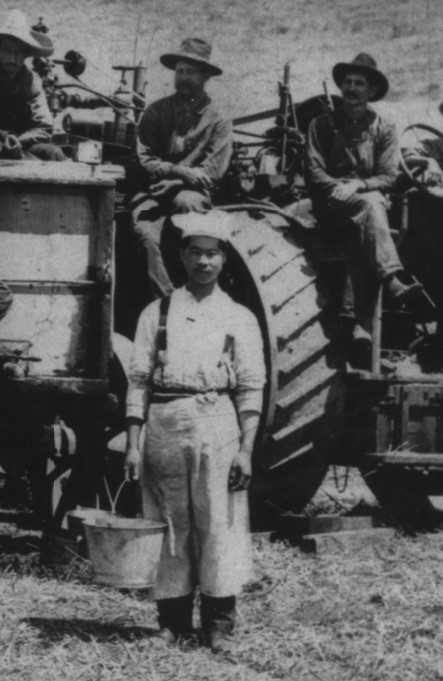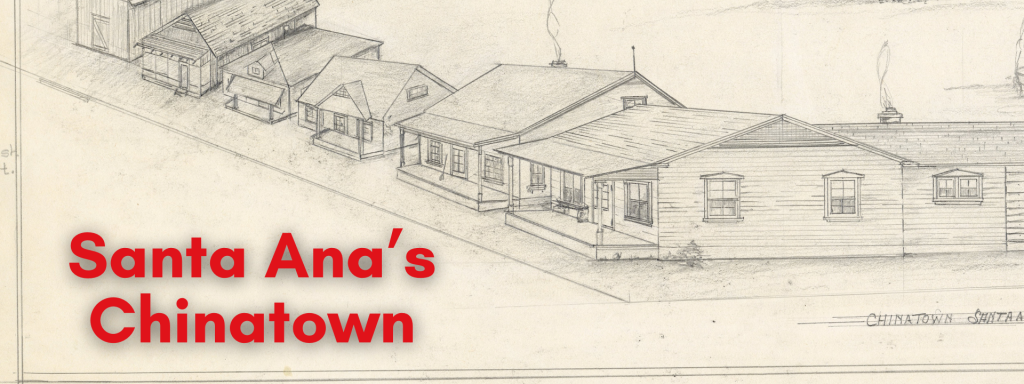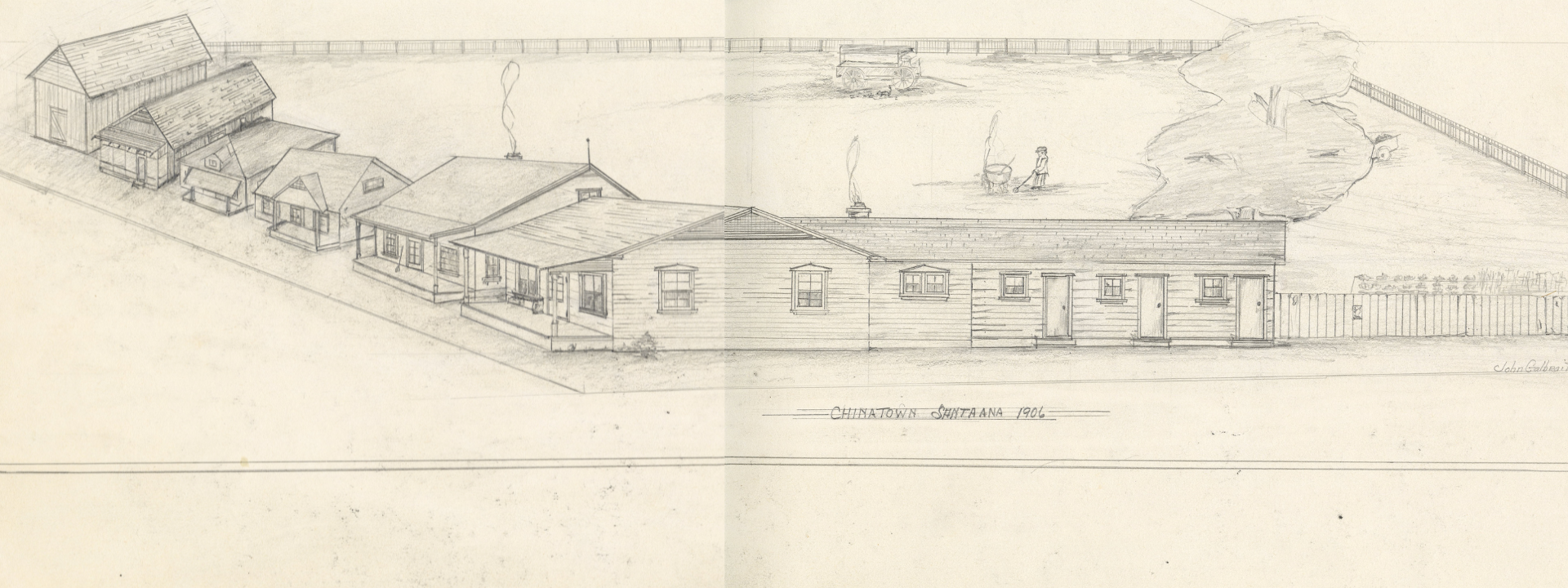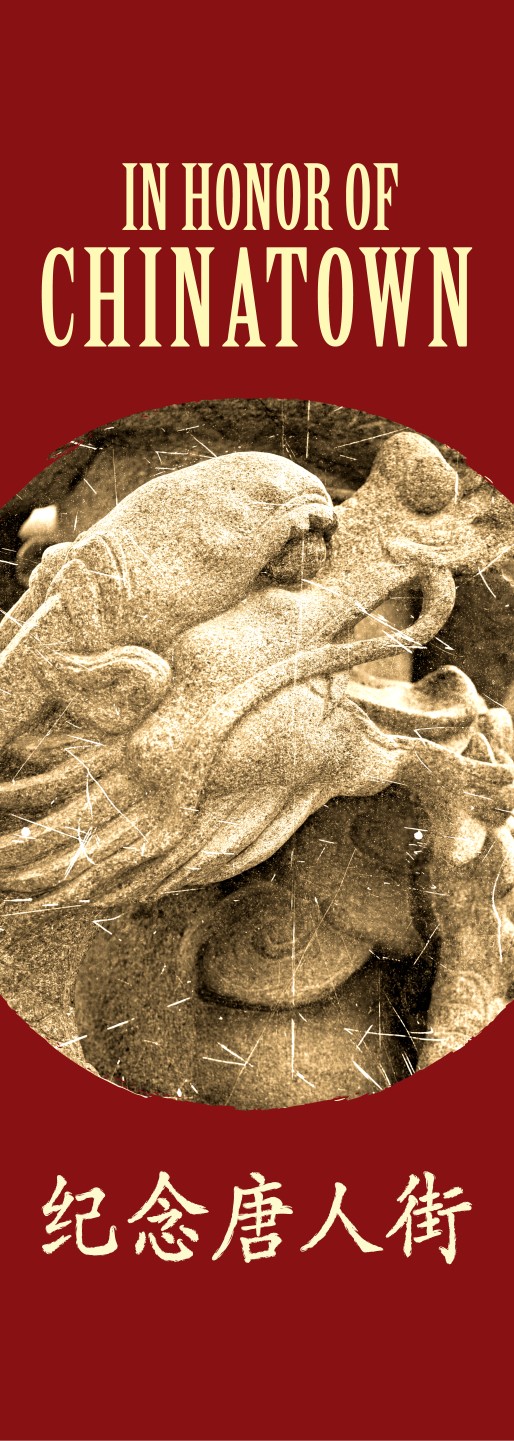Santa Ana’s Chinatown Memorial

Chinese-Americans were part of the early history and contributed to building of the agricultural industry and building of roads and railroad lines from Los Angeles and other communities as well as making contributions to the City's growth since the late 1800s. Today, Chinese American business and property owners as well as community leaders make Santa Ana a thriving environment for residents and visitors.
Chinese Migration to America
Chinese immigration to the United States has a long and complex history that spans several centuries. The first significant wave of Chinese immigrants arrived in the United States during the mid-1800s. Many came from the southern coastal provinces of China in search of better economic opportunities.
Many Chinese immigrants were recruited by American industrialists and drawn by the California Gold Rush in 1848 and later sought employment in industries like mining, agriculture, and railroad construction. Chinese labor played a crucial role in the construction of the First Transcontinental Railroad, which was completed in 1869. After the railroad's completion, many Chinese laborers remained in the United States and settled in various parts of the country. Some made their way to Orange County and then into Santa Ana.

Chinese Discrimination
During the late 19th century, Chinese immigrants in the United States faced widespread injustice and discrimination, particularly after the completion of the First Transcontinental Railroad. Anti-Chinese sentiment was fueled by a combination of economic factors, cultural misunderstandings, and racist attitudes. Several factors contributed to this hostile environment and the Chinese community endured numerous forms of mistreatment and marginalization:
- On April 26, 1858, the California legislature (Senate and Assembly) was among the first states to enact exclusion legislation with “An Act to Prevent Further Immigration of Chinese or Mongolians to This State.” Fortunately, this Act was legally challenged and was held to be unconstitutional. Unfortunately, this Act was not officially repealed until 1955, and other laws were passed that were designed to inconvenience and humiliate Chinese immigrants.
- Chinese Exclusion Act (1882): The first federal law to explicitly target and ban a specific ethnic group from immigrating to the United States.
- Restrictive State Laws: Several States enacted laws that specifically targeted Chinese immigrants, such as laws prohibiting Chinese individuals from owning property or marrying outside their race.
- Labor Exploitation & Economic Discrimination: Chinese immigrants often faced exploitative labor conditions. Many employers pushed them into labor-intensive and low-paying jobs.
- Segregation: Chinese immigrants were often confined to specific neighborhoods or ghettos known as "Chinatowns." While these communities provided a sense of support and familiarity, they were also subject to scrutiny and discrimination.
- Stereotyping and Racial Prejudice: Chinese immigrants were often depicted in derogatory and racist ways in popular media and political cartoons, perpetuating harmful stereotypes and further marginalizing the community.
Santa Ana’s Chinatown

In the late 1800’s, a community of over 200 Chinese immigrant workers occupied a part of Downtown Santa Ana. “Santa Ana’s Chinatown was located on the south side of Third Street between Main and Bush, just east of the present Old City Hall and presently lies mostly beneath a black-topped city parking lot.” (Sleeper, 1970 p. 31) During its peak years, there were as many as 800 Chinese residents living in Santa Ana. They took over abandoned abode huts, or any quarters they could find, and used them as shops and living quarters.
These residents were nation builders and despite considerable discrimination against these Chinese residents, by the late 1860’s they thrived. Chinese workers built most of the irrigation canals, drained swamps, cultivated the agricultural industry and built the railroad infrastructure of Orange County in the late 1800s. Santa Ana’s Chinatown once included lodging, drugstores, curio shops, two Chinese wash houses and a vegetable garden and barn. It was a community.
These residents jump started the celery business and brought along their own means of business such as laundry business, truck farming and the peddling of produce from horse drawn wagons. Their forced labor contributed to the creation of railroad construction, irrigation canal digging, agricultural pursuits, and fishing camps across the county.
Santa Ana’s Chinatown was often the target of racial slurs and justification to marginalize their community described as the “smelly” or “ratty” area of the City. In 1888, the Santa Ana Herald published that the Santa Ana City Board of Trustees was implored to “eradicate this plague spot – this eyesore of the City.” In 1903, the City purchased a site for their new City Hall. The bargain price of $859 is generally thought to be due to its proximity to Santa Ana’s Chinatown.
Burning of Santa Ana Chinatown
By 1904, Santa Ana’s Chinatown was now located next to the new City Hall and would later be burned down at the hands of the City. Santa Ana's Chinatown also fell victim to constant raids. On May 24, 1906, City Trustee President George A. Edgar and City Health Officer J. I. Clark inspected Chinatown themselves. They described finding an old Chinese man with "horrible sores'' of leprosy in a darkened room. The name of the gentlemen whom they found was Wong Wuh Ye. He had been a resident of Santa Ana for over 15 years. Upon the discovery, Chinatown was placed on an immediate quarantine and the matter would be brought up to the City’s Board of Health the same night. The following day, Resolution No.416 was passed.

Resolution No. 416: “Therefore, The Board of Trustees of the City of Santa Ana does hereby resolve and declares the following: Resolved, that the buildings at the corner of Bush and East Third streets known as “Chinatown” are each and all of them a public nuisance by reason of having been occupied by a leper and all of said building"
On May 25, 1906, the Daily Evening Blade published, that Resolution No. 416 was passed; Santa Ana’s Chinatown was burned down. The Evening Blade newspaper would go on to describe the tragedy as a “free show” to watch. The inhabitants were forced to vacate their homes and were unable to take any of their animals or belongings for fear of infection.
The burning down of Chinatown in Santa Ana was one of the most brazen, racist acts, which was officially sanctioned by the Santa Ana Board of Trustees in 1906. This anti-Asian violence is exemplary of the racially motivated hate that was generated by the Chinese Exclusion Act of 1882.


Apology from the City of Santa Ana
On May 24, 2022, the Santa Ana City Council along with Chinese American leaders gathered near the site of the Chinatown fire, located approximately at 253 E. 3rd Street for a ceremonial signing of the Chinatown apology resolution. The previous week, the Santa Ana City Council unanimously passed a resolution officially apologizing for the burning down of Chinatown as well as past anti-Chinese racism. Many who attended the ceremony welcomed this apology. Linn Lee, U.S. history and social studies curriculum specialist with Santa Ana Unified School District (SAUSD), commented, “It’s the first step in reconciliation. If this moment turns into a plaque where students can visit and discuss this incident, then this is a really good point in starting to heal.” And long-time residents like Wally Lau, son of Fred Lau who first migrated to Santa Ana in 1949 and started Santa Ana Market had this to say, “It’s the start of a healing process of telling people the true history of Santa Ana not just for Asian Americans but other people, also.” “We can move forward together as Americans while honoring our diverse cultures and roots and building a community where we all have a place to live as neighbors,” said Alan Woo, Chair of the Santa Ana Chinatown Apology and Memorial Committee.
Bibliography
Arellano, Gustavo. “A Racist Mob Burned Santa Ana’s Chinatown to the Ground. It Still Serves as a Lesson.” Los Angeles Times, March 21, 2021. https://www.latimes.com/california/story/2021- 03-18/lost-santa-ana-chinatown-shows-la-anti-asian-violence-legacy.
Arellano, Gustavo. “Santa Ana Deliberately Burned Down Its Chinatown in 1906-and Let a Man Die.” OC Weekly, December 30, 2014. https://www.ocweekly.com/santa-ana-deliberately-burned-down-its- chinatown-in-1906-and-let-a-man-die-to-do-it-6446664/.
Chiotakis, Steve. “Santa Ana Burned down Its Chinatown in 1906. What Are Its Lessons on Anti-Asian Hate?” KCRW, March 22, 2021. https://www.kcrw.com/news/shows/greater-la/affordable-housing-oscars-oc/santa-ana-chinatown-anti-asian.
George, Stephanie, and Carlota F. Haider. Sowing dreams, cultivating lives: Nikkei farmers in pre-World War II Orange County. Fullerton, CA: Center for Oral and Public History, California State University, Fullerton, 2009.
Gould, Stephen. California Chinese: The story of the six companies and the Chinese experience in Anaheim. Fullerton, CA: RB Publications, 2004.
Gould, Stephen. Chinese in Tustin. Yorba Linda, CA: Shumway Family History Services, 1989.
Gould, Stephen. The burning of Santa Ana’s Chinatown and the murder of Anaheim’s mock law fat. Hollywood, CA: Sun Dance Press, 1995.
Historic Building Survey, 1985-1986. Irvine, CA: Orange County Japanese American Council, 1986.
Kobayashi, James, and William F. Gulley. Japanese American experience in Orange County. Fullerton: Oral History Program, California State University, Fullerton, 1998.
Nitta, Minoru, John McFarland, and Alexander Nalle. Minoru Nitta. Fullerton, CA: California State University, Fullerton, Center for Oral and Public History, 2006.
Novotny, Adrian S. The early history of the Chinese in California: With a focus on Orange County. Long Beach, CA, 1985.
San Roman, Gabriel. “City of Santa Ana Marks Apology for Past Chinatown Burning with Ceremonial Signing.” Daily Pilot Times & OC. May 29, 2022, Daily Pilot edition.
Sleeper, Jim. “Two Tales of the Dragon: The Night They Burned Chinatown.” Orange County Illustrated VIII, June 1970.
Sweet, Cheryl. War letters: A tour of the “nam.” Santa Ana, CA: Pygmalion Press, 1996.
The Vietnamese community in Orange County: An oral history. Santa Ana, CA: Vietnamese Chamber of Commerce in Orange County, 1991.
Whitcomb, Janet. A municipal fire: The demise of Santa Ana’s Chinatown, 1986.
